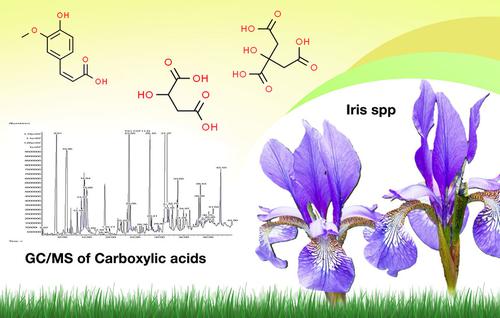当前位置:
X-MOL 学术
›
Chem. Biodivers.
›
论文详情
Our official English website, www.x-mol.net, welcomes your
feedback! (Note: you will need to create a separate account there.)
The comparative analysis of carboxylic acid composition of four Iris species from Ukraine
Chemistry & Biodiversity ( IF 2.3 ) Pub Date : 2021-02-10 , DOI: 10.1002/cbdv.202000969 Olha Mykhailenko 1 , Zigmantas Gudžinskas 2 , Svitlana Romanova 3 , Tetyana Orlova 4 , Sofiia Kozyra 3 , Svitlana Harna 5 , Victoriia Volochai 6
Chemistry & Biodiversity ( IF 2.3 ) Pub Date : 2021-02-10 , DOI: 10.1002/cbdv.202000969 Olha Mykhailenko 1 , Zigmantas Gudžinskas 2 , Svitlana Romanova 3 , Tetyana Orlova 4 , Sofiia Kozyra 3 , Svitlana Harna 5 , Victoriia Volochai 6
Affiliation

|
The present article reports results of analysis of carboxylic acids in leaves of Iris species from Ukraine using a gas chromatography (GC) method with mass spectrometric (MS) detection (GC/MS). Carboxylic acids play significant roles in contemporary society as evidenced by multiple applications in fields of medicine, agriculture, pharmacy, food, and other industries. Study of natural plant products as a source of organic acids is of particular interest. Carboxylic acid composition of leaves of Iris hungarica Waldst. & Kit., Iris germanica L., Iris pallida Lam., and Iris variegate L. was studied for the first time applying GC/MS method. The mass spectrums of compounds were matched with NIST and WILEY Libraries. The GC-MS analysis revealed the presence of 26 common acids in the plant raw materials studied. The short-chain carboxylic acids, such as citric (1337.5 - 12364.4 mg/kg), malic (50.8 - 4558.0 mg/kg) and oxalic (1199.0 -3435.2 mg/kg) acids were contained in significantly high quantity in all samples. Ferulic, p-coumaric and vanillic acids were the most abundant among phenolic acids. α-Linolenic acid was dominant in the leaves of I. germanica (869.5 mg/kg), I. pallida (753.3 mg/kg), and I. variegate (250.3 mg/kg) among polyunsaturated fatty acids however, linoleic acid prevailed in the plant raw material of I. hungarica (1150.7 mg/kg). Since the leaves of Iris species studied contain carboxylic acids with diverse pharmacological activity extracts of these raw materials are perspective for development food supplements and medicines.
中文翻译:

乌克兰四种鸢尾属植物羧酸组成的比较分析
本文报告了使用气相色谱 (GC) 和质谱 (MS) 检测 (GC/MS) 方法对乌克兰鸢尾属植物叶片中的羧酸进行分析的结果。羧酸在当代社会中发挥着重要作用,在医学、农业、制药、食品和其他行业领域的多种应用证明了这一点。作为有机酸来源的天然植物产品的研究特别令人感兴趣。Iris Hungarica Waldst 叶子的羧酸组成。& Kit.、Iris Germanica L.、Iris pallida Lam. 和 Iris variegate L. 首次应用 GC/MS 方法进行了研究。化合物的质谱与 NIST 和 WILEY 库匹配。GC-MS 分析显示所研究的植物原材料中存在 26 种常见酸。短链羧酸,在所有样品中,柠檬酸 (1337.5 - 12364.4 mg/kg)、苹果酸 (50.8 - 4558.0 mg/kg) 和草酸 (1199.0 -3435.2 mg/kg) 等酸的含量都非常高。阿魏酸、对香豆酸和香草酸在酚酸中含量最高。在多不饱和脂肪酸中,α-亚麻酸在 I. Germanica (869.5 mg/kg)、I. pallida (753.3 mg/kg) 和 I. variegate (250.3 mg/kg) 的叶片中占优势,而亚油酸在I. Hungarica的植物原料(1150.7 mg/kg)。由于所研究的鸢尾属植物的叶子含有具有多种药理活性的羧酸,因此这些原材料的提取物可用于开发食品补充剂和药物。2 mg/kg) 酸在所有样品中的含量都非常高。阿魏酸、对香豆酸和香草酸在酚酸中含量最高。在多不饱和脂肪酸中,α-亚麻酸在 I. Germanica (869.5 mg/kg)、I. pallida (753.3 mg/kg) 和 I. variegate (250.3 mg/kg) 的叶片中占优势,而亚油酸在I. Hungarica的植物原料(1150.7 mg/kg)。由于所研究的鸢尾属植物的叶子含有具有多种药理活性的羧酸,因此这些原材料的提取物可用于开发食品补充剂和药物。2 mg/kg) 酸在所有样品中的含量都非常高。阿魏酸、对香豆酸和香草酸在酚酸中含量最高。在多不饱和脂肪酸中,α-亚麻酸在 I. Germanica (869.5 mg/kg)、I. pallida (753.3 mg/kg) 和 I. variegate (250.3 mg/kg) 的叶片中占优势,而亚油酸在I. Hungarica的植物原料(1150.7 mg/kg)。由于所研究的鸢尾属植物的叶子含有具有多种药理活性的羧酸,因此这些原材料的提取物可用于开发食品补充剂和药物。3 mg/kg) 在多不饱和脂肪酸中,亚油酸在 I. Hungarica 的植物原料中占优势(1150.7 mg/kg)。由于所研究的鸢尾属植物的叶子含有具有多种药理活性的羧酸,因此这些原材料的提取物可用于开发食品补充剂和药物。3 mg/kg) 在多不饱和脂肪酸中,亚油酸在 I. Hungarica 的植物原料中占优势(1150.7 mg/kg)。由于所研究的鸢尾属植物的叶子含有具有多种药理活性的羧酸,因此这些原材料的提取物可用于开发食品补充剂和药物。
更新日期:2021-02-10
中文翻译:

乌克兰四种鸢尾属植物羧酸组成的比较分析
本文报告了使用气相色谱 (GC) 和质谱 (MS) 检测 (GC/MS) 方法对乌克兰鸢尾属植物叶片中的羧酸进行分析的结果。羧酸在当代社会中发挥着重要作用,在医学、农业、制药、食品和其他行业领域的多种应用证明了这一点。作为有机酸来源的天然植物产品的研究特别令人感兴趣。Iris Hungarica Waldst 叶子的羧酸组成。& Kit.、Iris Germanica L.、Iris pallida Lam. 和 Iris variegate L. 首次应用 GC/MS 方法进行了研究。化合物的质谱与 NIST 和 WILEY 库匹配。GC-MS 分析显示所研究的植物原材料中存在 26 种常见酸。短链羧酸,在所有样品中,柠檬酸 (1337.5 - 12364.4 mg/kg)、苹果酸 (50.8 - 4558.0 mg/kg) 和草酸 (1199.0 -3435.2 mg/kg) 等酸的含量都非常高。阿魏酸、对香豆酸和香草酸在酚酸中含量最高。在多不饱和脂肪酸中,α-亚麻酸在 I. Germanica (869.5 mg/kg)、I. pallida (753.3 mg/kg) 和 I. variegate (250.3 mg/kg) 的叶片中占优势,而亚油酸在I. Hungarica的植物原料(1150.7 mg/kg)。由于所研究的鸢尾属植物的叶子含有具有多种药理活性的羧酸,因此这些原材料的提取物可用于开发食品补充剂和药物。2 mg/kg) 酸在所有样品中的含量都非常高。阿魏酸、对香豆酸和香草酸在酚酸中含量最高。在多不饱和脂肪酸中,α-亚麻酸在 I. Germanica (869.5 mg/kg)、I. pallida (753.3 mg/kg) 和 I. variegate (250.3 mg/kg) 的叶片中占优势,而亚油酸在I. Hungarica的植物原料(1150.7 mg/kg)。由于所研究的鸢尾属植物的叶子含有具有多种药理活性的羧酸,因此这些原材料的提取物可用于开发食品补充剂和药物。2 mg/kg) 酸在所有样品中的含量都非常高。阿魏酸、对香豆酸和香草酸在酚酸中含量最高。在多不饱和脂肪酸中,α-亚麻酸在 I. Germanica (869.5 mg/kg)、I. pallida (753.3 mg/kg) 和 I. variegate (250.3 mg/kg) 的叶片中占优势,而亚油酸在I. Hungarica的植物原料(1150.7 mg/kg)。由于所研究的鸢尾属植物的叶子含有具有多种药理活性的羧酸,因此这些原材料的提取物可用于开发食品补充剂和药物。3 mg/kg) 在多不饱和脂肪酸中,亚油酸在 I. Hungarica 的植物原料中占优势(1150.7 mg/kg)。由于所研究的鸢尾属植物的叶子含有具有多种药理活性的羧酸,因此这些原材料的提取物可用于开发食品补充剂和药物。3 mg/kg) 在多不饱和脂肪酸中,亚油酸在 I. Hungarica 的植物原料中占优势(1150.7 mg/kg)。由于所研究的鸢尾属植物的叶子含有具有多种药理活性的羧酸,因此这些原材料的提取物可用于开发食品补充剂和药物。











































 京公网安备 11010802027423号
京公网安备 11010802027423号